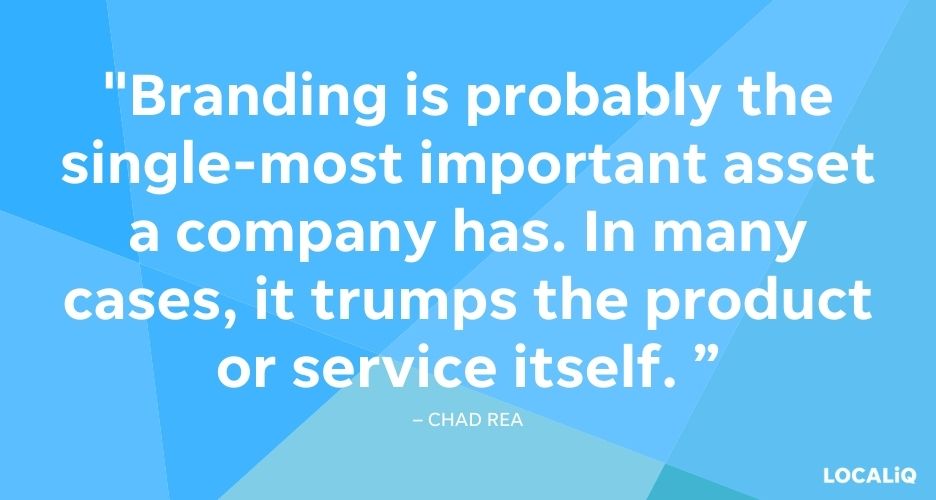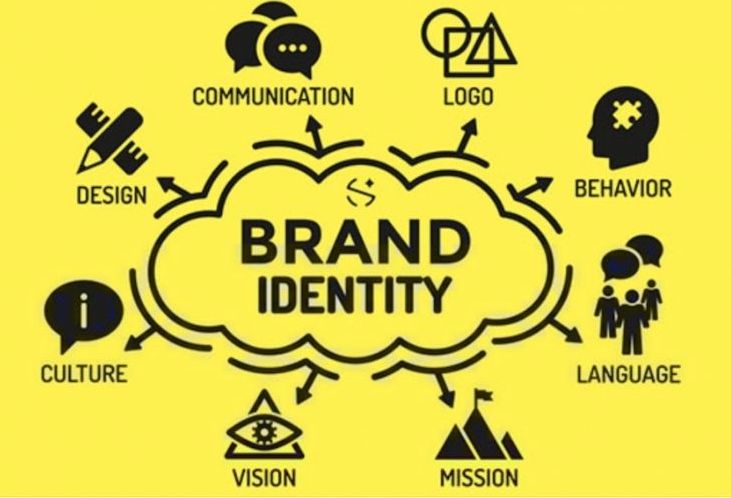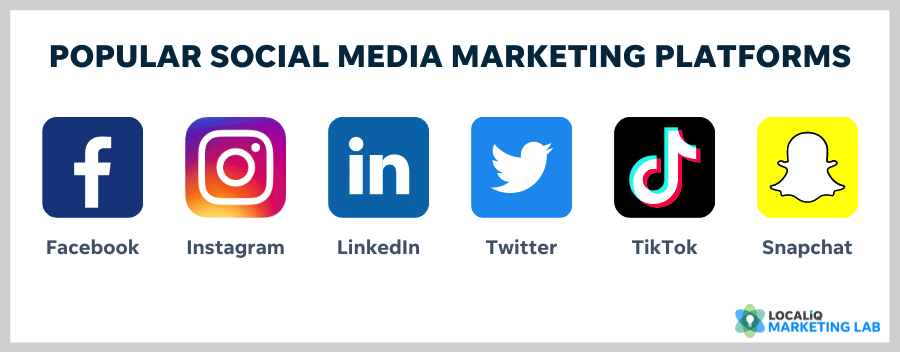Brand is everything. There are many products and services that have similar quality and offerings, but what is it that makes consumers choose Apple, Nike, Coca-Cola, BMW, or Starbucks over other options? What is it that turns a buyer into a brand ambassador who engages on social media, waits in long lines for new releases, and chooses to pay more for your product? (Part of) the answer is brand identity. A brand makes you feel something.
Chad Rea, a well-known creative director, and artist shares just how crucial this piece of your business is, “Branding is probably the single-most important asset a company has. In many cases, it trumps the product or service itself. Companies who invest in the often-lengthy process, as well as the ongoing brand guardianship, don’t have to keep introducing themselves every time they enter the room.”

Of course, the global brands listed above can execute this. They have multimillion-dollar budgets and access to the best marketers and creative directors in the world. That’s a far cry from me and you working from our home offices or running our local businesses, right? Well, I have good news for you. While developing a strong and effective brand identity requires purpose and takes time, it is very attainable for those of us without huge budgets or art degrees.
In this article, I’m going to share everything you need to know to create a brand identity, including:
- What brand identity is.
- Why brand identity is important.
- 8 steps to build a brand identity.
- When to spend money in the process.
- How to keep your brand identity consistent across all your marketing.
What is brand identity and why is it important?
Brand identity encompasses all the aspects of your business that you want to communicate to customers as well as how you communicate it to them. This includes understanding who your business is, what you offer, and your brand personality and then translating that into your brand materials such as your business name, logo, website, and marketing materials.

Brand identity is important for many reasons:
- Brand identity is the personification of your brand which can help you connect with customers.
- Developing a strong brand identity can help you be consistent in your business and marketing materials, which leads to increased awareness for your business.
- Your brand identity can help you stand out from other businesses in your market.
- A strong brand identity can increase customer loyalty and trust in your business.
8 steps to create a brand identity
Now that you understand what brand identity is and why it matters for your business, here are the eight steps to build brand identity (using my own experience as an example).
Step 1: Identify and create your mission statement
While each aspect is not technically difficult, every facet of your brand identity should be developed very purposefully. Your mission, company name, logo, colors, tone, and sound all need to be created for a specific reason. To do this, you must first identify who you are and what you want to do. What is your mission?
My favorite TED Talk of all time is Simon Sinek’s “How Great Leaders Inspire Action,” where he details “what is your why?” I love this because it really helps me think past my offerings to the core of why I’m doing what I do. More than selling a product or providing necessary services, think about the reason you started your business. What is the result for people who buy what you are selling?

For me, I had led esports initiatives for a few global organizations and wanted to focus on the specific aspect of those jobs that I found most enjoyable–brand strategy–and tie that to my overall focus in life, adding value to the people around me in ways that matter to them. This is quite broad, so it needed to narrow it down to fit a mission statement:
Through content, public speaking, and consulting, [business name] works with brands and agencies to help engage the esports and action sports subcultures. We add value to communities by enhancing experiences through meaningful brand partnerships that drive results.
This statement concisely communicates the following:
- What I want to do
- How I plan to do it
- Who I’m impacting
- How I’m impacting them
- The end result for my clients
This format can be used for any type of business to help your customers quickly understand what you provide, and also, to remind you of your brand story as your business grows and evolves.
Related: Small Business Branding Basics + Ideas to Get Started
Step 2: Come up with a business name
Now that we have our mission, we can develop the business name. When creating a name, I take Shakespeare’s advice, “What’s in a name? That which we call a rose by any other name would smell as sweet.”
While it seems counterintuitive, the name of your company is one of the least important parts of your brand. Nike is not successful because they chose the name of a Greek goddess, nor does the book Moby Dick have anything to do with the rapid growth of Starbucks any more than Apple selecting a specific fruit.
It is everything you do around the name that makes it worthy of consumers’ hard-earned money and loyalty. However, while we don’t want to get caught up on the name, I do believe in taking the opportunity to be strategic where we can.

I wanted the name of my company to reflect what I provide: Value. I took a page out of Nike’s playbook and discovered that the word “Value” in Greek is “Axía.” What a cool-sounding and visually interesting word! I began to get excited about developing an identity around this word that would be impactful and instantly recognizable, catapulting me to fame and fortune, and then…I did a quick Google search and found out that just about every consulting company out there had the same idea. I was reminded that differentiation is one of the important aspects of brand identity. I continued to search for a name that rolled off the tongue and could become synonymous with my mission. I pivoted from foreign languages to gaming terms and found it: DLC.
In the video game world, DLC stands for “Downloadable Content”–characters, skins, levels, and other features made available after the game has been released. Essentially, in-game value. Thinking about how esports and the broader marketing world are already in existence, my company’s entrance into the space adds additional value, similar to downloadable content.
Additionally, it turned out to be a convenient coincidence that my last name is Davidson, and I was starting a Company…All I needed was that “L.” Thinking back to my GameStop days, I remembered that one of our leaders would consistently talk about “learnings”–“the acquisition of knowledge or skills through experience, study, or by being taught.”
With the realization that this marketing term perfectly embodied my offerings and fulfilled my need for an “L,” Davidson Learning Company was born.
You may follow a similar process when it comes to naming your business or go a different route altogether. Here are some business name ideas to get your creative juices flowing.
Step 3: Create a business logo
Now I needed a mark to consistently represent my brand across all visual mediums.
A small business logo can be one of the most difficult design projects you come across. It’s not that logos are incredibly complicated. In fact, the issue is the opposite. Logos are not visually interesting, impressive illustrations. They are simple, two-dimensional marks that are recognizable in one color, at a small size. Try to remove the memories and experiences that you’ve had with these brands, and take a look at the marks below from some of the most successful companies of all time:

None of the logos from these award-winning brands would win an award at an art show. What makes a logo impactful are the experiences that one has associated with that mark. The advertisements, brand activations, store environment, tone, look, feel, and emotion all work together to turn a logo into a symbol of something much greater.
The biggest challenge during the logo development process is to eliminate emotion while selecting a symbol that will represent something you care about more than nearly anything else in life. To do this, you must focus on what makes a great logo. I call it the t-shirt test. If your logo can be clearly recognized, embroidered on a t-shirt at the size of the Lacoste Alligator on a polo, you’ve got yourself a workable logo.

I worked with a designer for my logo. We talked at length about my business, what I wanted to convey, and my inspiration, and then carefully selected the font (Sans Forgetica font, a typeface developed to aid memory retention) and colors (gold to reinforce the meaning of “value” and black as a strong complementary color).
It is important that along with your logo, you request a brand guide, which is easily shareable to partners and vendors to help them understand how your brand identity should accurately be represented. This can simply provide logos, colors, and fonts, or it can go deeper into examples of dos and don’ts. Make sure the brand guide is provided in .ai formats for designers and .pdf and .jpg formats in case it is shared with a contact who does not have Adobe Illustrator.

While there are many low-cost logo design options online, I do encourage you to support designers when you have the budget to do so. A great designer is worth every penny. It is important to recognize when you need to hire an expert and when you can design assets yourself while staying on-brand. Perception is reality. The interest in your product or services will be greatly affected by how your brand is presented each time.
Related: Get templates, examples, and tips to build an impactful small business brand kit.
Step 4: Determine your brand voice
The next step is to evaluate and determine what the tone of your brand will be. I enjoy this aspect most. Because DLC is a personal brand, there is a lot of myself in the identity. Take some time to identify some aspects of your brand identity. These aspects help you craft content, determine how to speak to your audience, and provide the flexibility to switch it up now and then.
Here’s an example of how Sprout Social outlines its brand voice.
Here are the brand identity aspects of DLC:
- Knowledgeable
- Grateful
- Motivational
- Fun
Each aspect is strategically based on how I’ve experienced my audience engaging with my content, how I can effectively communicate my value, and simply what I enjoy doing.
Step 5: Create your business website
With a solid logo, established brand colors, fonts, design elements, and a solid brand voice to guide me, I now had all the tools to take on a previously intimidating task–creating my website.
This can be another major headache when building your brand identity. It’s not enough to go with the website that looks the best or adheres to your newly-created brand guidelines. Your website needs to be built for search engine optimization, lead capturing and conversion, and user experience.

SEO and web design go hand-in-hand, so how your website is built is extremely important.
It can be quite challenging to find the right web developer and designer, so make sure to do your research and invest your time and marketing budget with a marketing partner who can do it for you.
Step 6: Create shareable marketing materials
As I looked to expand my brand identity, the next step in this process was to develop professional materials that were easily shareable and concisely presented who I am and what my business does. A best practice in business is to require as little work from your potential customers as possible. A link to a website homepage is not nearly as impactful or convenient as a PDF, brochure, or link to a specific page on your website that clearly communicates your offering and engages the audience to want to know more. Essentially, this comes down to creating a one-pager for your business.

This exercise can also help you narrow down the most important aspects of both your business and your brand. What do you want customers to know about you? How can you communicate that in a persuasive way?
Step 7: Build your brand presence on social media
To engage your audience, the next step is to expand your brand past your website through a strong social media presence.
As a solopreneur or small business owner, you have a lot to juggle, and managing five social media platforms doesn’t lighten your load. The first step in understanding how to effectively expand your brand across social media is understanding which platform your desired audience is on. If you haven’t already evaluated where you have the largest following or are receiving the highest engagement, there are resources to help you understand which types of audiences populate various social platforms.

We detail the top social media platforms and who uses each in our social media marketing course.
My audience is mainly on LinkedIn, where I post five days a week, on average. That content is then dispersed to Instagram, Twitter, or both, depending on the content. Through all different aspects, the most important piece is the consistency of images and copy. Consistency is key to building a strong brand identity.
Related: Check out these social media hacks to build your brand on social.
Step 8: Create (and share) content that aligns with your brand identity
Since the beginning, content has been one of the three core pillars of my business. In order to easily and consistently generate content, I wanted to develop a mechanism that would produce content for me. Thus, The DLC DROP Podcast was born, with the theme of telling the stories of industry leaders, insights learned through their career paths, and predictions of future trends. This additional medium provides challenges and opportunities to maintain and strengthen DLC’s brand identity.
In the same way, you’ll want to identify ways to solidify your brand identity with your target audience, whether that’s creating content on your website in the form of a blog, keeping your social media calendar packed with posts, or investing in video marketing to connect with your customers in that way.

No matter what type of content you create, it’s important to maintain your brand identity throughout, including in your marketing messaging, images, color palette, and more. This can increase brand awareness for your business, differentiate your business from the competition, and help you build a brand community.
Related: Find out how to measure brand awareness here.
Develop your brand identity to build awareness for your business
Developing a brand identity is a journey, and maintaining it is a daily task. The repetition of consistent experiences will build recognition with your audience, ultimately resulting in sales and loyalty, in coordination with excellent product and service experiences of your business.
Unfortunately, one off-brand experience can push customers away and have you starting over from step one. For this reason, it is important that you protect your brand identity at all costs. Here are some key takeaways for building a brand identity:
- Make sure your brand guidelines are easily accessible and clear for partners and vendors who are utilizing your logo to ensure that your brand’s identity is safe in hands beyond your own.
- Keep examples handy to remind yourself how your brand should look and sound each time it’s experienced and across every medium.
- Have fun developing the look, feel, and tone to represent what your brand is all about, and don’t forget to put some of yourself in it as well.
Brands start as an idea; colors, shapes, and words give them an identity; and consistency over time makes them iconic.
Want to learn more? Find out how to write your business description to build off your brand identity, then see about us page examples that can take your website to the next level.







